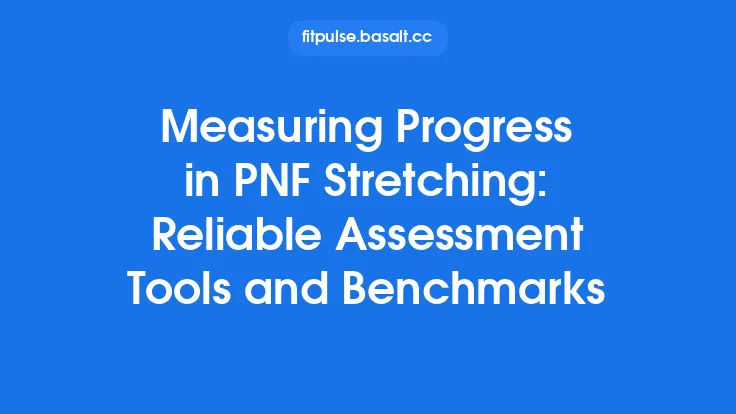Active Isolated Stretching (AIS) is prized for its ability to improve joint range of motion while maintaining muscle activation. Yet, without a systematic way to gauge progress, practitioners can easily lose sight of whether their efforts are translating into measurable gains. This article delves into the most reliable flexibility tests, the science behind tracking tools, and practical strategies for turning raw data into actionable insights. By the end, you’ll have a clear roadmap for establishing baseline values, monitoring change over time, and interpreting results with confidence—ensuring that every AIS session moves you closer to your mobility goals.
Why Objective Measurement Matters
- Accountability: Concrete numbers provide motivation and a sense of achievement that subjective “feeling looser” cannot match.
- Program Optimization: Data reveal which muscle groups respond quickly and which lag, allowing you to adjust volume, intensity, or frequency.
- Injury Prevention: Sudden drops in range or asymmetries can flag emerging issues before they become painful setbacks.
- Scientific Rigor: When you can demonstrate statistically significant improvements, you contribute to the broader body of evidence supporting AIS.
Core Principles of Reliable Flexibility Testing
| Principle | Description | Practical Tip |
|---|---|---|
| Standardization | Keep testing conditions (time of day, warm‑up status, equipment) consistent. | Test at the same hour, after a light 5‑minute dynamic warm‑up, and on the same surface. |
| Specificity | Choose tests that reflect the joint angles targeted in your AIS routine. | If you focus on hip external rotation, use a seated hip external rotation test rather than a generic sit‑and‑reach. |
| Reproducibility | The test should yield similar results when repeated under identical conditions. | Perform three trials and use the average; discard outliers beyond 2 SD. |
| Validity | The measurement must truly represent the flexibility attribute you intend to assess. | Use goniometric measurements for joint‑specific ROM rather than whole‑body flexibility proxies. |
The Most Trusted Flexibility Tests for AIS Practitioners
1. Goniometer‑Based Joint Range of Motion (ROM)
- What it measures: Angular displacement of a specific joint (e.g., hip flexion, shoulder internal rotation).
- How to perform:
- Position the limb in the neutral starting position.
- Align the stationary arm of the goniometer with the proximal segment’s longitudinal axis.
- Align the movable arm with the distal segment.
- Record the angle at the end of a passive stretch (or at the point of mild discomfort).
- Pros: High specificity, widely accepted in clinical settings.
- Cons: Requires a trained examiner; inter‑rater reliability can vary.
2. Inclinometer/Smartphone Apps
- What it measures: Similar angular data as a goniometer but using a digital inclinometer or a calibrated smartphone app.
- How to perform: Attach the device to the limb segment (e.g., thigh for hip flexion) and record the angle as the joint moves through its full stretch.
- Pros: Portable, cost‑effective, data can be exported directly to spreadsheets.
- Cons: Calibration is essential; some apps may have latency issues.
3. Sit‑and‑Reach Test (Modified)
- What it measures: Combined flexibility of the hamstrings and lumbar spine.
- How to perform:
- Sit on a flat surface with legs extended, feet against a box or ruler.
- Reach forward as far as possible, keeping knees straight.
- Record the distance reached beyond the toes (positive) or short of the toes (negative).
- Pros: Simple, no equipment beyond a ruler.
- Cons: Influenced by limb length and spinal flexibility; not joint‑specific.
4. Passive Straight‑Leg Raise (SLR)
- What it measures: Hamstring and hip flexor flexibility.
- How to perform: With the subject supine, lift the straight leg passively until resistance is felt, then measure the angle between the raised leg and the table using a goniometer or inclinometer.
- Pros: Isolates hamstring stretch, easy to replicate.
- Cons: Requires a helper to ensure passive movement.
5. Shoulder Flexion/Abduction Test
- What it measures: Glenohumeral joint ROM in the sagittal and frontal planes.
- How to perform: Using a goniometer, measure the angle from the anatomical position to the maximal passive flexion or abduction.
- Pros: Directly relevant for AIS shoulder protocols.
- Cons: Scapular motion can confound pure glenohumeral measurements; consider using a scapular‑fixation technique.
6. Functional Movement Screens (FMS) – Deep Squat and Lunge
- What it measures: Integrated mobility of the ankle, knee, hip, and thoracic spine.
- How to perform: Follow the standardized FMS protocol, scoring each movement on a 0‑3 scale.
- Pros: Provides a holistic view of mobility patterns.
- Cons: Scoring is somewhat subjective; best used alongside quantitative tests.
Establishing a Baseline: The First Data Set
- Pre‑Test Warm‑Up: A brief (5‑minute) dynamic routine ensures muscles are not cold, which can artificially limit ROM.
- Multiple Trials: Perform three repetitions per test, resting 30 seconds between attempts. Use the mean value to reduce random error.
- Document Context: Note the time of day, recent training load, hydration status, and any perceived soreness. These variables can influence flexibility.
- Create a Master Sheet: Include columns for:
- Date
- Test name
- Raw measurement (degrees or centimeters)
- Average of trials
- Subjective rating of stretch tolerance (1‑10)
- Comments (e.g., “tightness in posterior chain”)
Tracking Tools: From Pen‑and‑Paper to Integrated Platforms
| Tool | Key Features | Ideal User | Cost |
|---|---|---|---|
| Paper Logbook | Simple tables, handwritten notes | Beginners, low‑tech environments | Free |
| Spreadsheet (Excel/Google Sheets) | Custom formulas, charts, conditional formatting | Anyone comfortable with basic data manipulation | Free |
| Dedicated Mobility Apps (e.g., ROM‑Tracker, FlexiFit) | Built‑in goniometer calibration, auto‑graphing, cloud sync | Coaches, athletes who want mobile access | $5‑$30/month |
| Wearable Sensors (e.g., Xsens, Delsys EMG‑Integrated) | Real‑time angle capture, motion analytics, data export | Researchers, high‑performance teams | $300‑$1500 |
| Video Analysis Software (e.g., Coach’s Eye, Dartfish) | Frame‑by‑frame angle measurement, side‑by‑side comparison | Clinicians, coaches who need visual verification | $20‑$100/year |
Building an Automated Progress Dashboard
- Data Input: Use a Google Form linked to a Google Sheet to capture test results instantly after each session.
- Processing: Apply a simple script (Google Apps Script) to calculate weekly averages and percentage change from baseline.
- Visualization: Insert a line chart for each joint/segment, overlaying a trendline to highlight directionality.
- Alert System: Set conditional formatting to flag drops > 5 % or asymmetries > 10 ° between left and right sides, prompting a review.
Interpreting the Numbers: From Raw Data to Meaningful Insight
1. Percentage Change vs. Absolute Change
- Absolute Change (e.g., + 8 ° hip flexion) is intuitive but can be misleading when baseline values differ widely among individuals.
- Percentage Change normalizes progress:
\[
\%\,\text{Improvement} = \frac{\text{Current} - \text{Baseline}}{\text{Baseline}} \times 100
\]
This metric is especially useful when comparing groups or tracking long‑term trends.
2. Minimal Detectable Change (MDC)
- Definition: The smallest change that exceeds measurement error, typically calculated as 1.96 × √2 × SEM (Standard Error of Measurement).
- Application: If the MDC for a shoulder flexion goniometer reading is 4 °, any improvement below this threshold may be noise rather than true adaptation.
3. Asymmetry Indices
- Formula:
\[
\text{Asymmetry (\%)} = \frac{|\text{Left} - \text{Right}|}{\frac{\text{Left} + \text{Right}}{2}} \times 100
\]
- Interpretation: Values > 10 % often warrant targeted unilateral work or a reassessment of technique.
4. Correlating Flexibility Gains with Performance Metrics
- Strength‑to‑Mobility Ratio: Track how increases in ROM affect strength outputs (e.g., squat depth vs. 1RM). A balanced ratio suggests functional flexibility.
- Movement Efficiency: Use video analysis to see if greater ROM translates into smoother, more economical movement patterns.
Frequency of Testing: Balancing Sensitivity and Fatigue
| Training Phase | Recommended Testing Frequency |
|---|---|
| Introductory (first 4 weeks) | Baseline + end‑of‑phase (once) |
| Progressive (weeks 5‑12) | Every 4 weeks |
| Peak/Competition | Every 6‑8 weeks, or after a deload |
| Maintenance | Bi‑annual or when a plateau is suspected |
Rationale: Flexibility adaptations occur more slowly than strength gains. Testing too often can introduce learning effects and unnecessary fatigue, while testing too infrequently may miss early signs of regression.
Common Pitfalls in Progress Tracking (and How to Avoid Them)
| Pitfall | Consequence | Solution |
|---|---|---|
| Inconsistent Warm‑Up | Variable baseline readings | Standardize a 5‑minute dynamic warm‑up before every test. |
| Relying on a Single Test | Over‑ or under‑estimation of true mobility | Use a battery of complementary tests (e.g., goniometer + functional screen). |
| Neglecting Subjective Feedback | Missed pain or discomfort cues | Pair each measurement with a 1‑10 stretch tolerance rating. |
| Data Entry Errors | Skewed trends, false conclusions | Automate entry via digital forms or double‑check manual logs. |
| Ignoring Asymmetries | Increased injury risk | Calculate and monitor asymmetry indices each session. |
Integrating Progress Data into Your AIS Programming
- Identify Lagging Areas: If hip external rotation improves only 2 % while other joints gain 8 %, allocate extra AIS sets to that movement pattern.
- Adjust Volume Based on MDC: Once a joint surpasses its MDC, consider reducing AIS volume for that area and reallocating time to weaker regions.
- Periodize Flexibility Work: Use the data to plan “flexibility loading” blocks—periods of higher AIS volume followed by deload weeks to consolidate gains.
- Feedback Loop: After each testing cycle, review the dashboard, set new SMART (Specific, Measurable, Achievable, Relevant, Time‑bound) mobility goals, and communicate them to athletes or clients.
Future Directions: Emerging Technologies for AIS Progress Monitoring
- Machine‑Learning‑Enhanced Video Analysis: Algorithms can automatically detect joint angles from smartphone footage, reducing reliance on manual goniometry.
- Wearable Inertial Measurement Units (IMUs): Real‑time angle capture during AIS sessions allows immediate feedback and on‑the‑fly adjustments.
- Cloud‑Based Collaborative Platforms: Teams can share dashboards, annotate trends, and integrate flexibility data with strength, nutrition, and sleep metrics for a holistic performance profile.
While these tools are still gaining mainstream adoption, early adopters report faster identification of plateaus and more precise prescription of AIS volume.
Bottom Line
Measuring progress in Active Isolated Stretching is not a luxury—it’s a necessity for anyone serious about translating flexibility work into tangible performance and health outcomes. By selecting reliable tests, standardizing protocols, leveraging modern tracking tools, and interpreting data through the lenses of MDC, asymmetry, and functional relevance, you turn every stretch into a data‑driven step toward greater mobility. Embrace the numbers, respect the nuances, and let the evidence guide your AIS journey.



